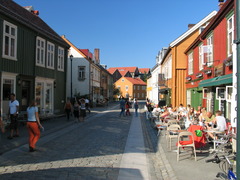Classroom:Norwegian Grammar Checking
Contents
Norwegian Grammar Checking
On clicking on the icon below, you get to an automatic parser of Norwegian designed to tell you, in case a sentence contains a grammatical mistake, what this mistake is.
Please click the icon. In the window that comes up, you feed a sentence into the parser by writing or copying it into the open line, and pushing the button 'Analyze'.
For instance, consider the following sentence:
Jeg liker du.
In this sentence, "du" is used as an object, but the form "du" can be used only as a subject. If you send the sentence through the parser, this is also what the parser will tell you. Thus, glue the sentence into the parse line, and push 'Analyze'. You get the following message:
"The word "du" is marked as the wrong case, try using "deg" instead".
To the left below this message, there is a small square with a number inside. Click on this square, and you get a new window showing, as 'generated sentence', the recommended form Jeg liker deg.
You can in principle use sentences of any length, but for the purpose of getting rapid feedback and precise advice about what (if anything) is wrong, we recommend using short sentences.
Using the grammar checker relative to a systematic course in Norwegian
A course like NoW given at NTNU has all its course material online, and the parser can be used in synchrony with the lessons of the course. The parser will then use the vocabulary of the course, and have all the grammar rules that the course provides. The parser allows you to test freely chosen sentences that you write.
One way of proceeding is that you refer to any sample text used in the course, and on a prompt question related to the text, write a short story/text as answer, using mainly the words used in the text, but in any grammatical structuring that you want to test out. For instance, the text may be the one for Lesson 5 in NoW, called "Maria" and illustrating inflections for Past tense, rendered below:
5 MARIA
Kjære mamma og pappa!
I dag syklet jeg til Bakklandet, et koselig område i nærheten av Trondheim sentrum. På Bakklandet er det mange gamle trehus i forskjellige farger. Det er også mange hyggelige kaféer og fine restauranter der. Jeg møtte Anna på en av kaféene, Dromedar Kaffebar. Jeg bestilte et stort stykke sjokoladekake og en kopp kaffe. Jeg betalte over 80 kroner for kakestykket og kaffen. Alt er så dyrt i Norge! Men kaka var kjempegod. Jeg spurte servitøren om oppskrifta, men den var hemmelig, sa han.
Anna er ei veldig hyggelig jente. Jeg er så glad for at vi er naboer. Vi satt på kaféen i over to timer, for vi hadde så mye å snakke om. Og tenk – sykkelen stod utenfor hele tiden – uten lås! Jeg glemte å låse den da jeg gikk inn. Jeg tror at Trondheim er en trygg by, og det er få fattige mennesker her.
Nordmenn er rare. De er snille og hyggelige, men de holder ikke døra åpen for deg. I går fikk jeg døra på postkontoret i ansiktet, og i dag døra på kaféen.
Pass godt på hverandre, og hils bestefar fra meg.
Hilsen Maria
Suppose that the prompt question is
Write 4-5 sentences in answer to the question:
"Hva gjorde du og Anna?"
and that you write the following:
Anna og jeg syklet til en kafe. Hun er min naboen. Vi snakte i to timer. Ingen stjelte syklen min, selv om den ikke var låst.
What is wrong here?
You can copy and paste one sentence after the other into the Grammar checker.
If you write the sentences first in a normal text editor, spell-checkers built into the editor may detect some of the mistakes, typically wrong spellings of words and wrong inflections. You may use this as a first sift, and then see what the parser says about the grammatical structure.
Relative to each phenomenon for which the parser gives an error message, TypeCraft will have a page with information about the phenomenon involved, in the form of short definitions, examples of correct forms for the phenomenon, and, for further investigation, more detailed explanations and reference to literature, as well as reference to other languages manifesting the same or similar phenomena. It of course also has a reference to the lesson in NoW where the phenomenon is explained.
For instance, for errors in the use of Past tense, in Norwegian called 'Preteritum', a comment like the following will be supplied:
GRAMMAR RULES
The past tense (preteritum)
The past tense (preteritum) refers to something that happened at a specific time in the past, or happened repeatedly in the past.
Norwegian verbs can be classified as either WEAK (endings are added to the root of the verb to form the past tense) or STRONG (involving a vowel change in the root -- often no ending at all.)
Basic Grammar Rules
There are fewer strong verbs than weak verbs, so you should learn to recognise those and then assume that the rest are weak.
Memorise the strong verb. The rest of the verbs are then the weak ones.
Also for the weak verb it must be learned how to form the past form from the verb root. However, the past tense of weak verbs follows an easily recognisable pattern.
There are four different endings for weak verbs (-et | -te | de | dde). These endings are always added to the stem or root of the verb. This root is found by dropping the unstressed -e on the end of the infinitive, if there is one.


